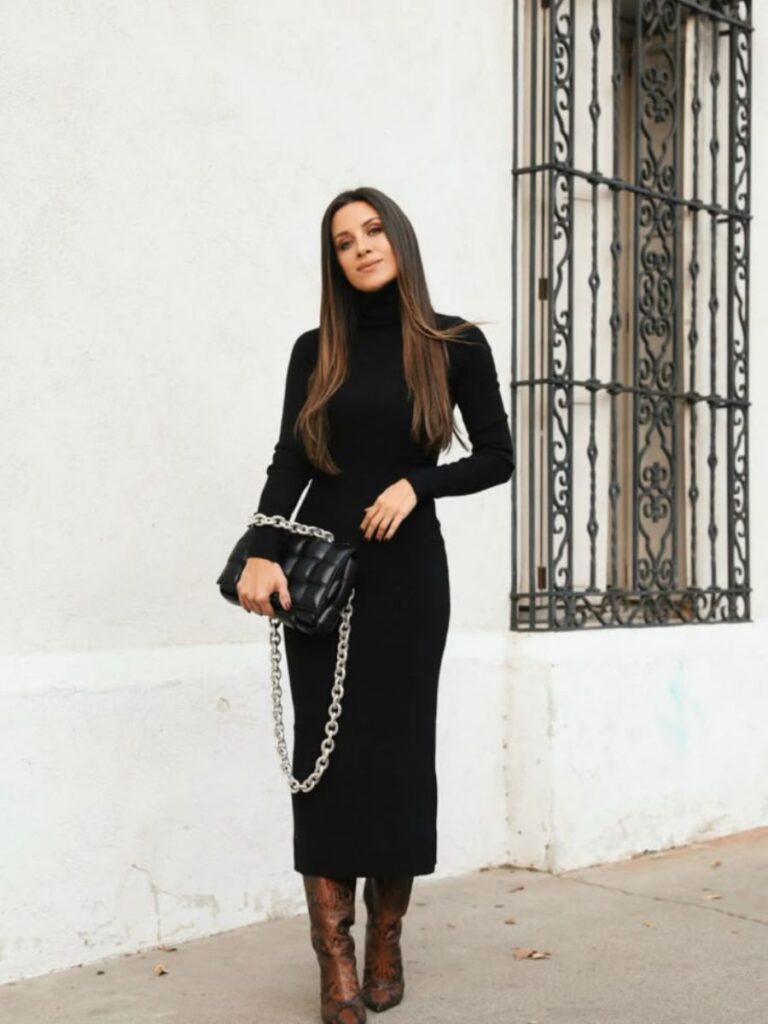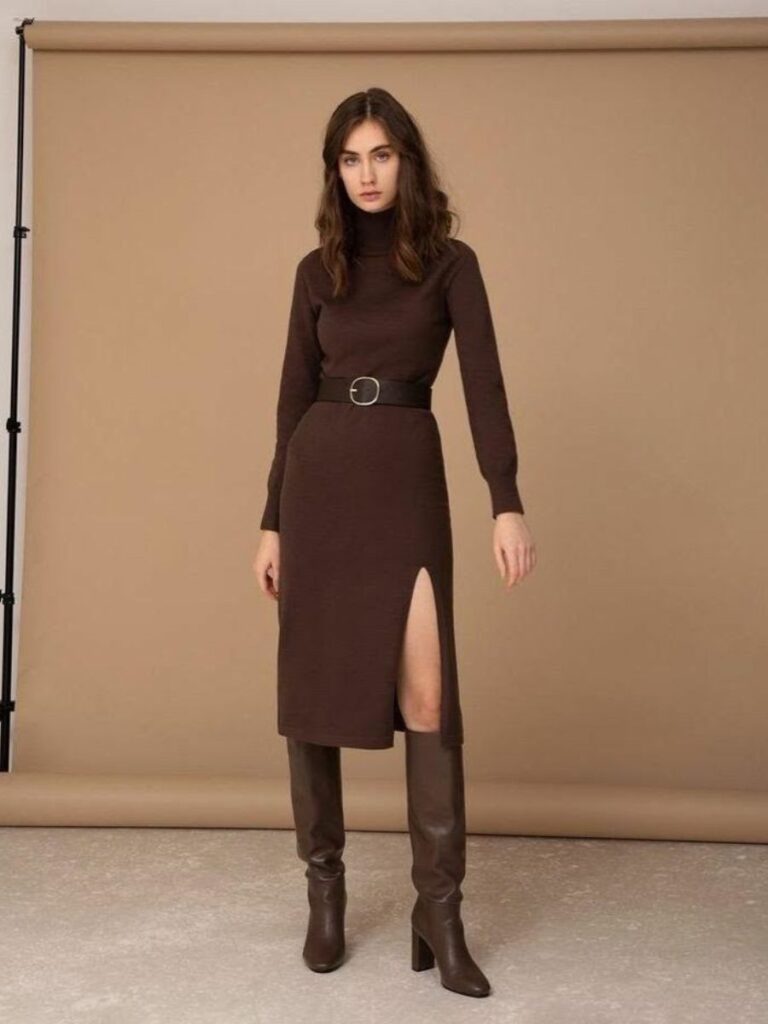There’s something undeniably appealing about the contrast between flowing feminine fabrics and structured, substantial footwear.
Yet many people hesitate when it comes to styling boots with long dresses, unsure whether the pairing looks intentional or like a fashion accident waiting to happen.
The truth is, when done right, boots and long dresses create one of the most versatile and effortlessly cool combinations in fashion, equally at home at music festivals and dinner parties, casual brunches and creative workplaces.
The key to nailing this look lies in understanding balance, proportion, and the specific magic that happens when you pair different boot styles with various dress lengths and fabrics.
It’s not just about throwing on any boots with any long dress, it’s about creating combinations that feel cohesive, intentional, and authentically you.

The boots-with-long-dress pairing works because it creates an intriguing style tension that’s both practical and visually interesting.
Long dresses bring femininity, flow, and elegance, while boots add structure, edge, and grounding weight. This contrast prevents outfits from feeling too precious or delicate while maintaining romantic appeal.
From a practical standpoint, boots offer comfort and versatility that traditional dress shoes might not provide.
You can walk longer distances, navigate various terrains, and transition seamlessly from day to evening activities.
There’s also something refreshingly modern about rejecting the traditional “dress equals heels” formula in favor of something more individual and lifestyle appropriate.
Cultural shifts in fashion have made this combination increasingly acceptable and even expected in many settings.
The rise of festival fashion, bohemian influences, and the general casualization of dress codes have all contributed to boots and long dresses becoming a mainstream styling choice rather than an edgy fashion statement.
How to Style Boots with Long Dresses
Ankle Boots
Ankle boots are probably the easiest entry point into the boots-and-long-dress world because they work with virtually every dress length and style.

The shorter boot height means you don’t have to worry about complex proportion issues – they simply ground your dress without competing for attention.
Classic leather ankle boots in black or brown provide the most versatility. They work with bohemian maxi dresses, structured midi dresses, and everything in between.
The key is choosing boots with clean lines that won’t overwhelm delicate dress fabrics or compete with interesting dress details.
Heeled ankle boots can dress up casual long dresses for evening wear or more formal occasions.
A moderate heel – around 2-3 inches – provides height without sacrificing comfort, making them perfect for events where you’ll be standing or walking for extended periods.
Suede ankle boots add textural interest and work particularly well with flowing, bohemian-style dresses.
The soft texture of suede complements romantic dress styles while the structured boot shape keeps everything grounded and wearable.
Combat-style ankle boots bring an edgier vibe to long dresses, creating interesting style contrasts. This combination works especially well with vintage-inspired dresses, creating a modern twist on classic silhouettes.
Knee-High Boots
Knee-high boots require more careful consideration but can create absolutely stunning combinations with the right long dresses.

The key is ensuring there’s enough contrast between the boot height and dress length to create intentional, balanced proportions.
With midi dresses, knee-high boots can create sleek, sophisticated silhouettes perfect for cooler weather.
The coverage provided by both pieces creates a polished, pulled-together look that works well for professional settings or dressy casual occasions.
Fitted knee-high boots work best with flowing dress styles because the contrast between structured boots and soft fabrics creates visual balance.
Avoid pairing very fitted boots with equally fitted dresses unless you’re specifically going for a more avant-garde, fashion-forward look.
Slouchy knee-high boots bring a more relaxed, bohemian vibe to long dress combinations.
These work particularly well with ethnic-inspired prints, flowing fabrics, or vintage-style dresses where the relaxed boot silhouette complements the dress’s casual elegance.
Heeled knee-high boots can transform long dresses into evening-appropriate attire. The added height and sophistication of heeled boots elevates casual dresses while maintaining comfort and practicality.
Over-the-knee boots
Thigh-high boots with long dresses are definitely a more advanced styling choice, but they can create incredibly chic, fashion-forward looks when executed properly.

This combination works best with shorter long dresses, pieces that hit at or just below the knee, where the boot height creates interesting negative space.
The key to avoiding costume territory is ensuring the overall proportions feel balanced and the styling feels intentional. Over-the-knee boots work best with simpler dress styles that won’t compete with the drama of the boots themselves.
Cowboy and Western Boots
Cowboy boots have experienced a major fashion renaissance and pair beautifully with long dresses for that modern western aesthetic.

The pointed toe and slight heel of traditional cowboy boots create an elongating effect that works well with flowing dress silhouettes.
With bohemian-style dresses, cowboy boots create a perfect festival or casual weekend look that feels authentically American and effortlessly cool.
Floral prints, flowing fabrics, and ethnic-inspired details all complement the western boot aesthetic.
Traditional leather cowboy boots in brown or tan work with earth-toned dresses and natural fabrics like cotton, linen, or wool. Black cowboy boots can create more modern, unexpected combinations with contemporary dress styles.
Embellished western boots with decorative stitching or hardware can become statement pieces that anchor simpler dress styles. The key is letting either the boots or the dress be the star, not competing for attention.
Fabric and Style Considerations
Flowing, lightweight fabrics like chiffon, crepe, or soft cotton work beautifully with structured boots because the contrast creates visual interest.
The substantial weight of boots provides grounding for fabrics that might otherwise feel too ethereal or insubstantial.
Structured dress fabrics like ponte knits, wool blends, or heavier cottons pair well with both fitted and relaxed boot styles.
The substantial nature of both pieces creates cohesive, well-balanced outfits that feel intentional and polished.
Knit dresses – especially sweater dresses – are natural partners for boots. The cozy, casual nature of knit fabrics complements the practical, comfortable nature of boots while maintaining sophistication and style.
Silk and satin dresses can work with boots for more unexpected, fashion-forward combinations.
The contrast between luxurious fabrics and casual footwear creates interesting tension that can look either elegantly unexpected or completely off-balance, depending on execution.
Length and Proportion Guidelines
Maxi dresses (ankle-length) work best with ankle boots or low-profile boot styles that won’t compete with the dress’s dramatic length.
The boots should complement rather than fight with the dress’s natural flow and movement.
Midi dresses (calf-length) offer the most flexibility in boot choices. Almost any boot height can work, from ankle boots to knee-high styles, depending on the specific proportions and styling goals.
Tea-length dresses (mid-calf) pair beautifully with ankle boots and can work with taller boot styles if there’s enough contrast between the dress hem and boot top to create intentional negative space.
Just-below-knee dresses can work with over-the-knee boots for more dramatic, fashion-forward looks, though this requires confidence and careful styling to avoid looking costume-like.
Seasonal Styling Strategies
Spring combinations focus on lighter boot styles with flowing dresses in fresh colors and prints.
Suede ankle boots with floral midi dresses create perfect transitional weather outfits that bridge winter’s structured pieces with summer’s feminine styles.
Summer styling might seem challenging for boots and dresses, but lighter boot materials like canvas or perforated leather can work with cotton or linen dresses for festival-inspired looks or air-conditioned indoor events.
Fall fashion is where boots and long dresses truly shine. Rich autumn colors, heavier fabrics, and layering opportunities create countless styling possibilities.
Knee-high boots with sweater dresses or ankle boots with flowing midi dresses capture the season’s romantic, cozy aesthetic perfectly.
Winter combinations allow for the most dramatic boot choices and substantial dress fabrics.
Over-the-knee boots with wool dresses, or insulated ankle boots with knit midi dresses provide both style and practical warmth.
Color Coordination and Contrast
Neutral boots – black, brown, tan, or gray – provide the most versatility and work with virtually any dress color or pattern. These colors allow your dress to be the focal point while the boots provide grounding and structure.
Statement boot colors like burgundy, forest green, or navy can add personality to neutral dresses without overwhelming the overall look. The key is choosing colors that complement rather than clash with your dress palette.
Matching boot and dress colors can create sophisticated monochromatic looks, especially in fall and winter when deeper colors feel most appropriate.
This approach requires attention to texture and silhouette to prevent the outfit from looking flat or boring.
Metallic boots – gold, silver, or bronze – can add glamour to simple dress styles, making them appropriate for evening events or special occasions while maintaining the comfort and practicality of boots.
Styling Mistakes to Avoid
Proportion mismatches are the biggest pitfall in boots-and-dress combinations. Avoid pairing very chunky boots with delicate, flowing dresses unless you’re specifically going for a contrast effect, and ensure that boot heights create flattering negative space rather than awkward cut-off points.
Over-accessorizing can make boots-and-dress outfits look cluttered or confused.
Since both pieces make their own style statements, keep accessories minimal and let the boots and dress relationship be the focal point.
Ignoring the occasion can result in inappropriate styling choices.
While boots and dresses can work for many occasions, consider whether the combination meets dress code expectations and feels appropriate for the specific event or setting.
Accessory Considerations
Belts can completely transform boots-and-dress combinations by creating waist definition and changing the overall silhouette.
A simple leather belt can make flowing dresses feel more structured and intentional when paired with substantial boots.
Outerwear should complement rather than compete with your boots-and-dress combination. Denim jackets, leather jackets, or structured cardigans all work well without overwhelming the outfit’s proportions.
Bags should match the overall vibe of your boots-and-dress combination.
Structured handbags work well with heeled boots and dressier dresses, while crossbody bags or slouchy totes complement casual boot and dress pairings.
Building Your Boots with Long Dress Wardrobe
Start with versatile pieces that can work in multiple combinations. A pair of quality black ankle boots and a few long dresses in different styles provide the foundation for countless outfit possibilities.
Consider your lifestyle when building this wardrobe. If you attend many outdoor events, prioritize comfortable, weather-appropriate boot styles. If you need options for professional settings, focus on more polished boot and dress combinations.
Invest in quality basics rather than trendy pieces that might quickly feel dated. Classic boot styles and well-made dresses in timeless silhouettes provide better long-term value and styling flexibility.
Conclusion
This combination offers comfort, style, and endless possibilities for personal expression.
The best outfits are the ones that make you feel confident, comfortable, and ready for whatever the day brings.
